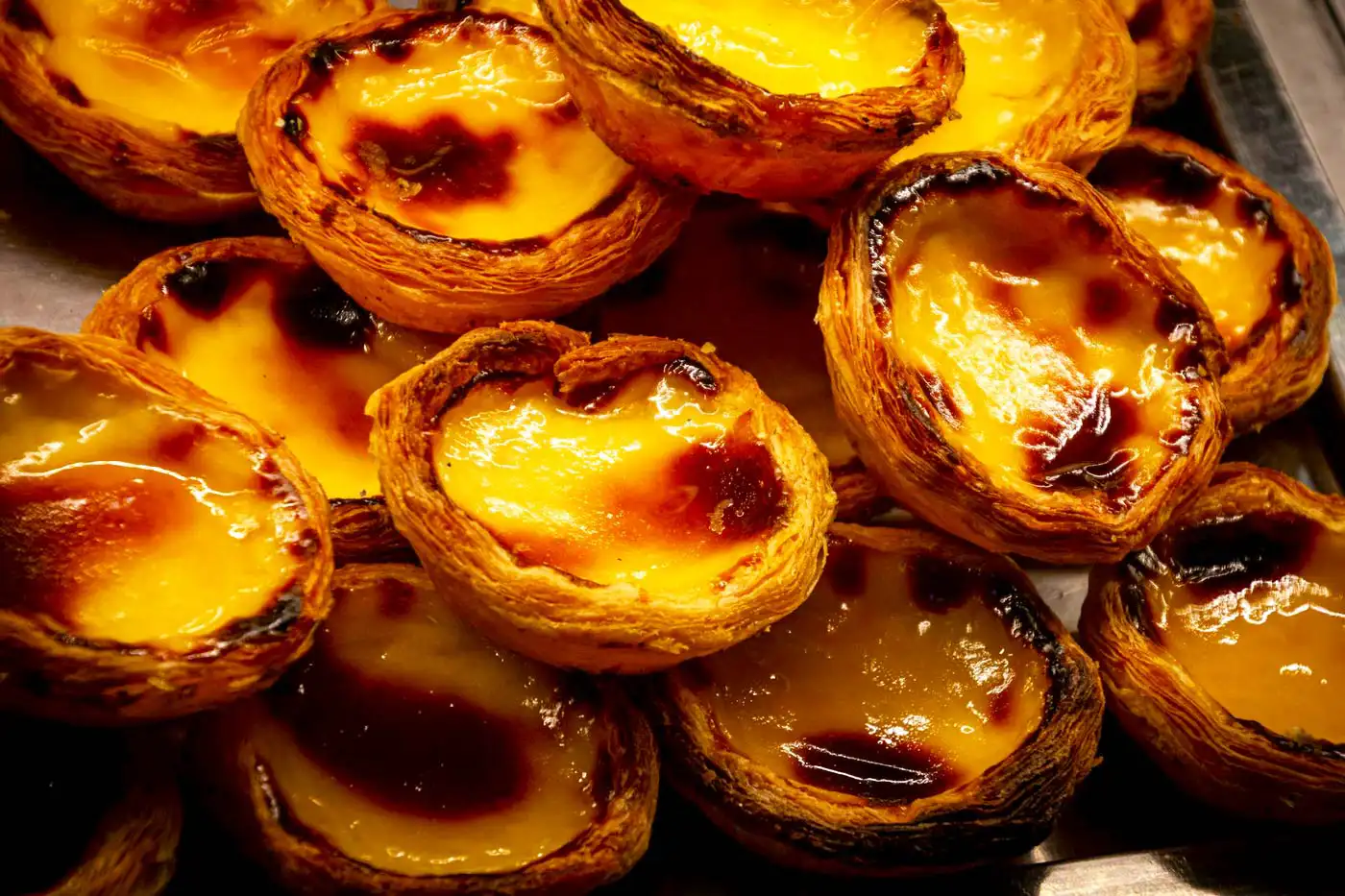A Madeiran Favorite From the Portuguese Mainland
Pastel de Nata (Pastel de Belém), or Portuguese custard tart or Doce Conventual (due to its religious background), is a Madeiran favorite that originates from mainland Portugal. The beloved pastry with a creamy custard filling and a crispy, flaky crust, often comes dusted with cinnamon and powdered sugar. Here’s a look at its rich history and what makes it so irresistible.
From Leftovers to Legend, How The Sweet Treat Survived Revolution and Secrecy
Pastel de Nata was created in the 18th century by monks at the Jerónimos Monastery in Lisbon. They had lots of egg yolks left over from using egg whites to starch clothes, so they made pastries to use them up. In 1820, the Liberal Revolution took place, which promoted secularization, aiming to reduce the power of the Catholic Church in Portuguese state affairs.
Monks of Jerónimos Monastery were struggling financially during this time, so they began selling their Pastéis de Natas at a nearby sugar refinery. Despite their efforts, the monastery still ended up closing in 1834 and the recipe of their specialty would then be sold to the owners of the sugar refinery. The refinery next opened the Fábrica de Pastéis de Belém, whereas Belém refers to the district, which started at a bakery next to the refinery, using the old “secret recipe” from the monastery. Today, the monastery is an influential tourist hotspot and has claimed the status as a UNESCO World Heritage Site.
This recipe has been handed down and is only known by the master pastry chefs who make the tarts by hand in the “Oficina do Segredo.” The pastry chef must sign a contract and swear to keep the recipe a secret. The recipe has not changed ever since.
What Is The Difference Between Pastéis de Nata and Pastéis de Belém?
While Pastéis de Belém is produced exclusively at the Fábrica de Pastéis de Belém in the Belém district of Lisbon, Portugal, Pastéis de Nata is a general name used for similar pastries made worldwide, often featuring significant variations in their recipes. Both the original recipe and the name "Pastéis de Belém" are patented.
In April 2019 Bloomberg publish an article about Pastel de Nata: “The Unlikely Rise of the Pastel de Nata” where it predicts that Pastel de Nata is on its way to becoming as ubiquitous as the croissant.
How Pastel de Nata Made It to Madeira
Pastel de Nata is believed to have arrived in Madeira during the 19th century, shortly after the closure of the Jerónimos Monastery. As the popularity of Pastéis de Nata grew, the recipe and the pastries began to spread beyond Lisbon. Local bakers started making their own versions of the custard tart, adapting the recipe to their tastes and available ingredients. Over time, Pastel de Nata became a beloved treat in Madeira. Today, while Pastel de Nata remains a favorite across Portugal, Madeira has developed its own variations and styles, celebrating the pastry as an integral part of its local cuisine.

Why Pastel de Nata is Famous, and Where?
The tart is famous for its mix of textures and flavors. The crispy pastry and smooth custard filling make it a favorite treat. It’s also popular in former Portuguese colonies like Brazil, Macau, and Goa, where it’s known as the Portuguese egg tart. It is well-known internationally. In 2009, The Guardian named Pastéis de Belém one of the 50 best things to eat in the world.
Pastel de Nata Fun Facts
High Demand: The Fábrica de Pastéis de Belém sells over 20,000 tarts every day.
Wedding Tradition: There’s a saying that a bride who eats a pastel de nata will never take off her ring, making them popular at weddings.
Gastronomic Wonder: In 2011, pastéis de Belém were voted one of Portugal’s Seven Wonders of Gastronomy.
Fast-Food Versions: Chains like KFC have their own versions of the tart in places like China, Hong Kong, or Singapore.
Where To Eat The Best Pastel de Nata in Madeira?
Looking for the best Pastel de Nata in Madeira? Look no further. Here are your best picks.
Nata 7
Located in the heart of Funchal, this charming café is a must-visit for pastel de nata lovers. Nata 7 offers a cozy atmosphere perfect for enjoying a sweet treat with a cup of coffee.
🕒 Opens every day at 09:00h except on Sunday (10:00h)
🌍 Nata 7 on Facebook
Petit Fours Patisserie
Situated near the Lido area, Petit Fours Patisserie is renowned for its exceptional pastel de nata. This delightful bakery offers a variety of pastries and cakes, making it a great spot for breakfast or an afternoon snack.
🕒 Saturday to Friday: 08:00h - 20:00h
🌍 Petit Fours Patisserie on Tripadvisor
Padaria Pastelaria Mariazinha
Located in the Old Town, Padaria Pastelaria Mariazinha is a favorite among locals and tourists alike. Known for its fresh and tasty pastel de nata, this bakery is the perfect place to experience traditional Portuguese pastries.
🕒 Open every day from 07:00h - 21:00h
🌍 Padaria Pastelaria Mariazinha on Tripadvisor
Pastel de Nata Recipe
Care about crafting your own Pastel de Nata? Give it a try. It is not difficult but there are a few essential steps:
Grease a 12-hole muffin tin and heat the oven to not more than 200°C.
In a saucepan, mix:
1 egg
3 egg yolks
100 grams of sugar
30 grams of cornflour.
Add 500 milliliters of milk while stirring until it is all smooth.
Next, place the pan over medium heat and stir constantly until the mixture thickens and starts boiling lightly.
Remove the pan from the heat and stir in 1 teaspoon of vanilla extract. Transfer the custard to a glass or ceramic bowl, cover it, and let it cool.
Cut a sheet of pastry into two pieces and stack them on top of each other. Roll the pastry tightly to form a log, then cut the log into 12 equal rounds.
On a lightly floured surface, roll each round into a disc about 10 centimeters in diameter, then press the discs into the muffin tin.
Spoon the cooled custard into the pastry cases and bake for 20 to 25 minutes, or until the tops are golden brown.
Let them cool in the tin for 5 minutes before transferring them to a cooling rack. They can be enjoyed warm or at room temperature.
Enjoy!








Comments